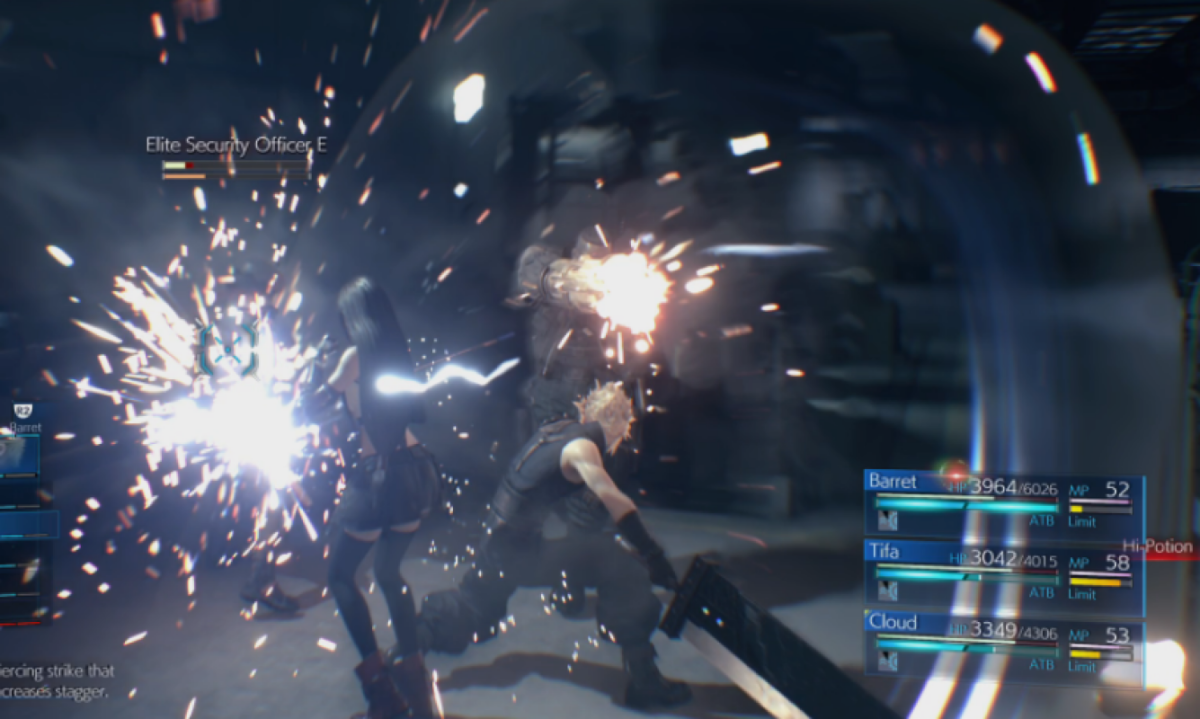There was a lot that impressed me about the Final Fantasy VII Remake, released 2020. For me, it set the standard for the full revitalization of an old game. Or rather, it would be if it weren’t only part one, a game that covers a fraction of the story of the original. Repackaging the story of one game into several full-sized, full-priced games, re-imagining the combat systems completely, expanding and rewriting the story. These are all controversial decisions, though they are assuaged somewhat by the existence of Ever Crisis, another full remake of Final Fantasy VII that is a more traditional, more faithful remake using updated assets. Indeed, there are so many interesting questions surrounding this game one could discuss. For now, let’s talk about the changes to Remake‘s combat systems, what experience they’re trying to accomplish, and why they are the way they are.
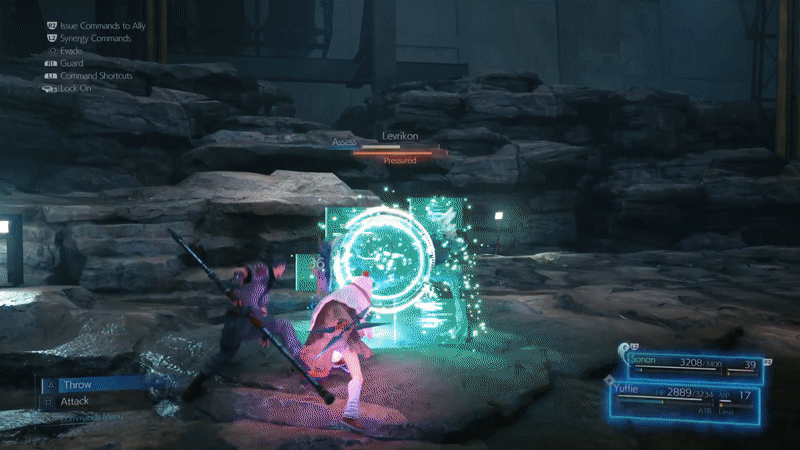
One feature of Remake‘s combat that I find most interesting is the presence of the ATB bar. For those unfamiliar, Final Fantasy has employed at various points since its fourth installment the Active Time Battle system, or ATB for short. For the folks who may have been riled by Square Enix’s recent efforts to bring Final Fantasy more into the realm of action games, and deployment of increasingly arcane systems combining action with turn-based combat, rest assured that this is not a new trend. They have been trying to do this since the 90s. In its traditional use, the ATB bar is a timer that counts down to when a player character can act in battle. The faster that character’s speed stat, the more often they can act. When action is not possible, characters stand idle. So essentially, it’s a traditional turn-based combat, but with the wrinkle of an active timer.
At the heart of the ATB system’s ambitions, successes, and failures, I think is this tension a lot of combat-oriented games experience between their action elements and strategic elements. There advantages in verisimilitude, theoretically, as a real-time element brings with it less abstraction, but also a loss of many of the advantages that turn-based represents.
Turn-based games are inherently strategic in their foundation. The benefit of having combat play out over an indefinite amount of time is giving the player the space to make informed and meaningful decisions to gain an advantage over the opposition, which is where the challenge in turn-based combat comes from. Enemies need to be powerful enough to require critical thinking and problem solving in order to be engaging. Problem solving and critical thinking requires time to think. On the other hand, action combat is often all about twitch reaction, muscle memory, and being present in the moment as developments unfold around you. This is why you often finding me describing real-time game systems as ‘action’ ones. Now, action games can and often do have strategic depth as well, but the strategy of a game like soccer exists on a different state of mind than a game like chess.
There is an inherent friction between these ideas that can crop up in any system that aims to combine the two experiences. If action is meant to be all about the pressure of events happening in real-time, when do you get the time to develop your strategy? If that space for critical thought and puzzle-solving is needed for a turn-based game to have its strategic depth, how do you provide that space without disrupting the flow and rhythm of an action game?
In the ATB system’s early uses, the main advantage I can see is its ability to offer variable turn frequency through the speed state. It’s an interest dimension to scale character power, not one that is super frequently employed in turn-based games. Usually enemies and players only get one turn each, in even ratio to one another. Allowing that ratio to change can create some very interesting scenarios. There are disadvantages though. Personally, I love taking my time to formulate the perfect strategy and course of action in any given situation in a turn-based game. It’s a big part of the draw for me. The ATB system, which allows enemies to continue acting in spite of the player, demands that one keep taking actions or quickly become overwhelmed. Older Final Fantasy games would often have a mode to address this, but the wait mode of of old Final Fantasy is effective the same as regular old turn-based, kind of defeating the purpose. I believe Final Fantasy VII Remake has an optional mode akin to this, though I would argue Remake’s combat is a fuller realization of ATB’s design goals regardless. The argument that the wait mode represents a lack of confidence in the ATB systems early on is stronger I think, when one examines Final Fantasy X, a game in which the speed stat still exists in the form of agility, but represents the frequency of turns for an actor within a non-real-time system. Static turns are simply queued up in an ordered list, with faster characters getting more turns. The real time element here, was unnecessary, and therefor not included.

What are those design goals then? Well going by the nomenclature it seems the Active Time Battle systems was meant to make turn-based combat more actively engage the player with its time-sensitive elements. Final Fantasy, like Dragon Quest before it, utilize turn-based combat akin to the tabletop games that inspired them. Turn-based combat was developed as a way to create an abstract representation of combat for the safe environment of a game. There aren’t a lot of practical ways to really play out hitting each other with swords while gathered around a table, without this layer of abstraction. Nowadays, I think there’s a lot of appreciation for the unique experiences possible only through a sophisticated turn-based system. I get the sense that even in the 90s, all the way up to now, some at Square Enix felt as though the turn-based system imposes limitations on what the combat can be, and imposes a barrier between the player and being immersed in the game’s world.
I think that last point is debatable, but what isn’t, so it seems to me, is that the ATB system wants the player to feel more pressured, with a more present sense of danger and action playing out in real-time. The problem for me, is that the simplicity of the ATB system feels like somewhat of a half measure. It’s a little at odds with the strategic systems of Final Fantasy combat, but also doesn’t fully create a sense of urgency or action for me. It’s kind of just a turn-based combat systems where you jump through a few extra hoops. The first real exception to this for me… is… not Final Fantasy VII Remake, which would come a lot later. Chrono Trigger is a vary notable instance of a game taking the ATB system and pushing it in an interesting direction.
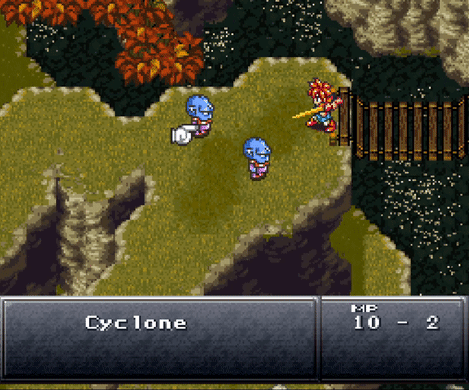
The key for what makes the ATB system work for me in Chrono Trigger is the importance of player and enemy positioning. Some of the Final Fantasy games had shades of this, but it was very digital and binary. IE: If you’ve ambushed enemies you have an advantage, if they’ve ambushed you, they have the advantage. In Chrono Trigger though, the relative position of enemies is analogue, constantly changing, and an ever-present strategic element. This element is often just a small, simple detail. For example, when several enemies are close together, you may be able to hit all of them at once with a single special attack, but not if they’re spread apart. If an enemy is too close to the player character when attacked, they may immediately respond with a counterattack. That sort of thing.
This simple extra dimension was like a missing link for me. Real-time is only one element of what makes action games engaging. In a traditional turn-based game. Things such as multi-hit attacks and counters are often very static and abstract. A multi-hit attack might always hit three enemies, or always hit enemies adjacent to one another, though they never move. In Chrono Trigger, and games influence by it, enemy positions are organic and ever-shifting, a natural and intuitive extension of the world. This ingredient alone makes the ATB bar make sense, as the dynamics of battle change in real-time along with the turn order. As I’ve often said elsewhere, relative position and spacing management on the part of the player is also an essential element. Chrono Trigger had a great commitment to holistic nature of its world. There are no random encounters. There are no battle transitions – the combat takes place in the same physical space it is initiated in. And, of course, battles occur in real-time. The game works to minimize abstraction in the broad strokes to make the game as seamless and cohesive as possible. Chrono Trigger brings these elements together in the context of a turn-based game, and was the last real evolution of the ATB system, in my opinion… until…
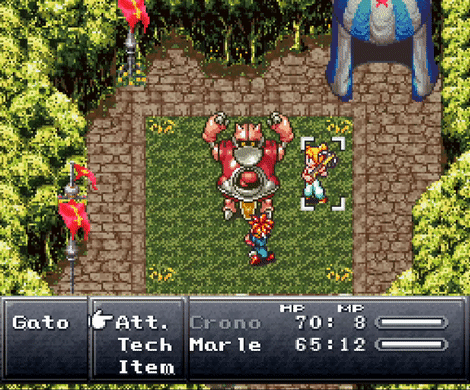
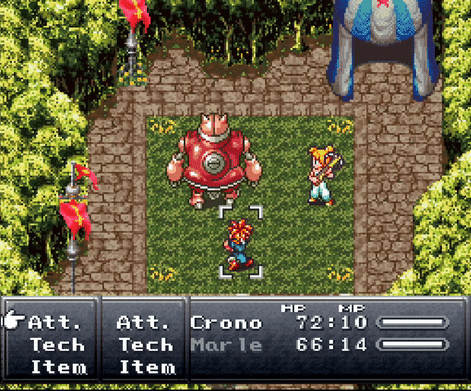
Well okay, there are a couple of other Square Enix games I want to talk about that finally lead us to where we are today with Final Fantasy VII Remake, but first I’ll finally talk about Remake. Remake‘s primary conceit in its combat is that you can run your player characters around a 3D space and directly command them to attack in real-time, taking after the likes of a Kingdom Hearts or Devil May Cry. While not as robust a system as those, Remake‘s action makes for an effective stopgap of realism to reinforce what is being represented by the more abstract strategic decision making that takes place between – the action forms an important bedrock of context. Kingdom Hearts is another series that initially attempted to marry turn-based combat’s strategic elements to an action system, but ultimately fell head-first into the symbolic dream-ocean of full-on action game by its first sequel. The wrinkle for Remake, though, is the player’s ability to pause the action at any time to assess the situation and execute specific commands for the party members, commands which are invariably a lot more powerful than the standard real-time attacks.
A lot of games have tried this ‘stop and go’ sort of combat. Most prominently I think of old CRPGs like Baldur’s Gate, Planescape: Torment, or Dragon Age for a more recent example. These games take direct inspiration from Dungeons and Dragons or are indeed, even licensed games tied to the property. Weirdly though they’d often not employ turn-based combat at all, unlike the actual tabletop game they’re based on, almost as if turn-based is this inherent limitation to be overcome. I wonder if the developers at Square Enix ever played these games, or were inspired by their indifference to turn-based combat, haha. Suffice to say I think turn-based combat has almost always been underappreciated for its merits in many spheres of video game development. What made combat for a game like Dragon Age a little dull for me, was in how the real-time segments and paused segments, the player characters’ capabilities are exactly the same. So ultimately, I just felt like I was disrupting whenever I needed to pause the game to line up a spell, and since all characters are only indirectly controlled through commands, I never felt fully engaged during real-time either.

This is where Final Fantasy VII Remake really accels, I think. It’s built on the solid foundation of an action game, with a full suite of direct control for the player, from blocking to dodging to parrying. And you’ll need those options, as the enemies take full advantage of their freedom of movement while the game is un-paused. Engaging with this action system builds up your ATB gauge, no longer a mere function of time, it is a function of engagement with the core systems. At certain thresholds of ATB, you can command a party member to unleash a powerful attack, and are given the ability to pause the action to carefully consider how and where to employ these ATB abilities. This pausing never disrupted the flow of the game for me, because they’re always big moments I was building to – rewards for effectively playing the game. The barrier between what can be done during real-time, and what cannot be, also very effectively delineates the two modes, so I never felt as if one is intruding on the other. I have to pause the game to heal a party member, or to unleash a skull-cracking dive kick. These actions are not something I can just do on the fly. They require strategy and consideration, so their presence within a pause sub-mode of the game feels natural. The ability to pause is a godsend too, as the player characters each have very intricate combat mechanics unique to them that, when used in tandem with careful consideration, can have some devastatingly powerful results.
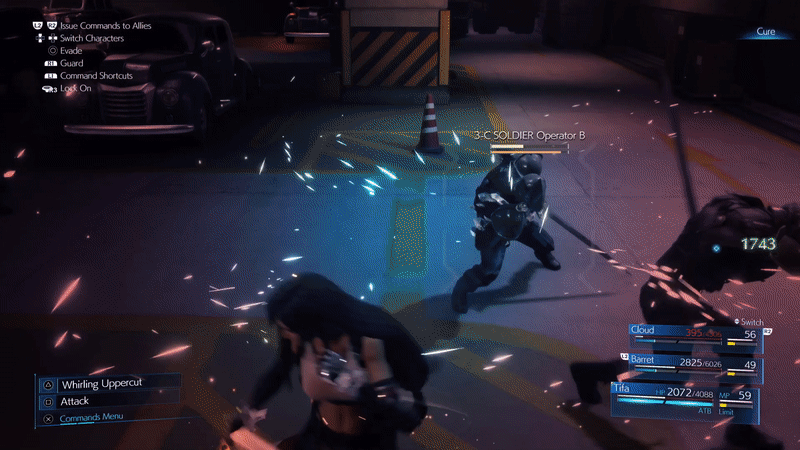
Another key to this is the stagger system, which is also an ongoing iterative system featured in many Square Enix games. It creates a long-term goal in any given combat encounter that the player can build up to. By using the right moves at the right times, enemies can be staggered, opening them up for massive damage. A balance of micro-goals and long-term goals is essential to a compelling combat system. From not getting hit, to setting up an enormous combo. It’s these interlaced interest curves, build ups and releases, that keeps combat from getting stale.
This makes for a sophisticated system of setups and payoffs, where every party member is instrumental in stringing together combination maneuvers. Cloud can easily set up a stagger on an enemy with his powerful counter attacks in real time and big sword strikes from the command menu. Meanwhile, Tifa can empower her abilities by stringing together a series of strikes. At the same time, Barret, who can take a lot of punishment, is safe to set up some buffs like haste to increase the party’s speed. Once the target is staggered, Tifa can unleash her built up power to fully exploit in the enemy’s weakness, and Cloud can finish them off once they’re low on health. The fantasy that Remake really delivers on for me is twofold; One, it creates this delightful scenario of being able to pause and survey a complex battlefield, almost like stepping into a freeze-frame of an action movie, owed to how well the real-time segments of the game operate in isolation to create impressive spectacle and compelling scenarios. I can survey these wild combat engagements with a strategic, discerning eye without fear of reprisal. Secondly, the way all of the character’s complex mechanics mesh together creates for me the sense that they are a real, team, working together to accomplish incredible things they could not do alone.
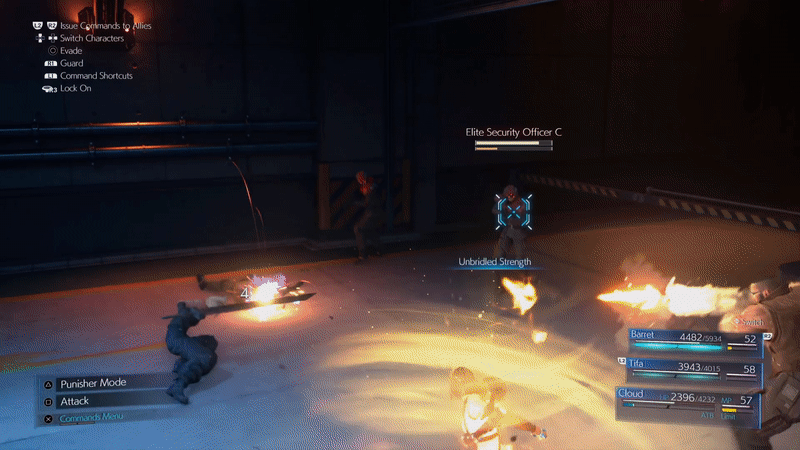
This schema didn’t appear fully formed in Remake from thin air or divine inspiration, though. Many might not realize Final Fantasy has been trying to achieve this awakening of the ATB system’s dream for years. I can think of three major stepping stones of this journey: Final Fantasy XIII, Final Fantasy XIII: Lightning Returns, and Final Fantasy XV. All three of these games have bits and pieces of the puzzle that would make up the combat system of VII Remake, each containing the germ of an idea that you can see grow into what we have today.
XIII established party-wide strategic command overlaid upon action that exists in a different mode from that strategy. There’s been a lot of criticism over the lack of player engagement for this in-between mode, but the basis of VII Remake started as far back as this game. It became an example how combing two modes of play without disrupting pacing could work, although the quality of the pacing of XIII‘s combat is debatable. The later sequel Lightning Returns did away party dynamics, but intimately explored the stagger system, and how indirectly controlling player characters in real-time could work.
XV was an interesting beast. The result of an overlong development time, branched off from a very different design concept that leaned more on action gameplay. XV shows signs of its troubled development, but I think none is more prominent than the combat system. It isn’t bad, per say, but it feels very underdeveloped. A lot of the ideas that shine in VII Remake exist here in a sort of primordial form. Optional wait modes exist alongside a limit-action systems that puts emphasis of enemies positioning, and party-wide combination attacks. Everything is just a little off. A lot of those micro-goals I mentioned don’t feel as though they are totally in-sync, and long-term goals within combat aren’t totally clear. Nothing quite meshes like it feels as though it should, but all the ideas are there. Whether you actually like these games or not, the long and short of this is that Final Fantasies XIII, XIII: Lightning Returns, and XV walked so VII Remake could run.
The old lessons from Chrono Trigger live at the heart of Final Fantasy VII Remake as well, with the relative positions of enemies and party members in 3D space determining how actions resolve. A big sword swing might hit a dozen enemies at once if you’re careful about positioning! This is taken further than Chrono Trigger even, with the ability to finely control exactly where each party member is standing, and a third dimension to play around with. It’s an intricate dance of set ups, payoffs, and strategic positioning wrapped in a solid-as-stone action game bedrock crafted by old hands when it comes to hack-and-slash ARPG gameplay.

So Final Fantasy VII Remake does not have turn-based combat, and that is an understandably big loss for some people. What it is not, however, is a turn-based combat system trying to masquerade as a hybrid of action and strategy. Rather, it is the realization of that decades long dream to create an engaging hybridization of strategy and action RPGs. It is at last, finally, the ATB system come home. It is the design goals set way back then finally pushed to their apex, at least so far. Fully realized, the ATB can shine in accomplishing what it’s struggled to do for years. I’m also pretty impressed, and thankful, that a second completely differently imagined remake of Final Fantasy VII is due in the form of Ever Crisis, which seems to retain the old combat system, as a companion piece to Remake. Remake‘s redone combat aims to capture its predecessor’s strengths in a heightened form. It’s a brilliant system to build off of in that regard, and has become one of the biggest reasons I remain very excited for the future installments of Final Fantasy VII Remake.
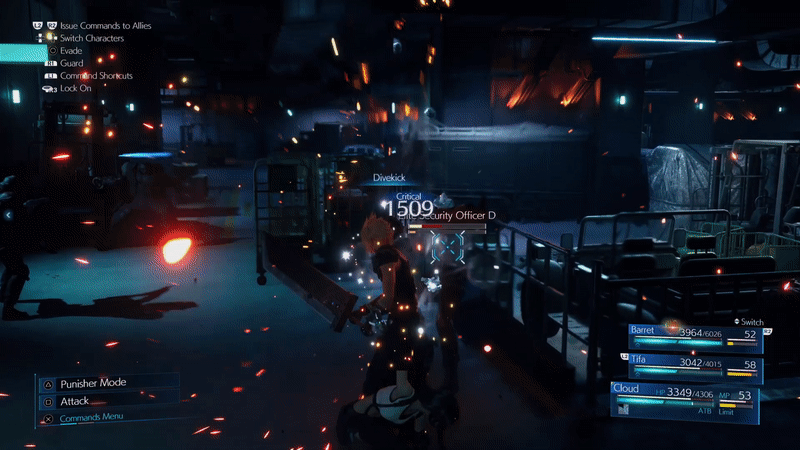
Attack while its tail is up! It’s gonna counterattack with its laser…
